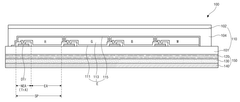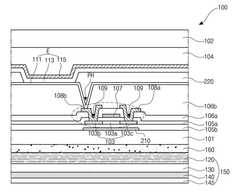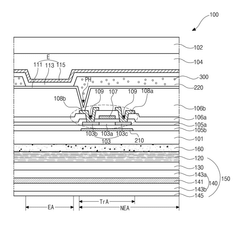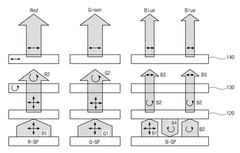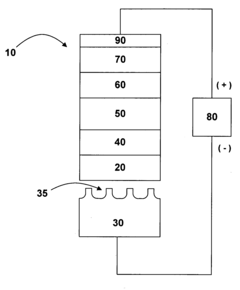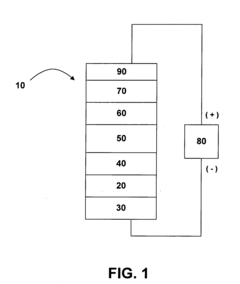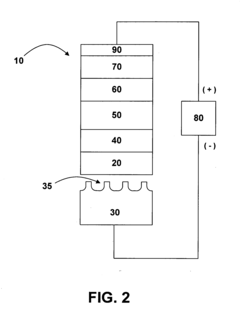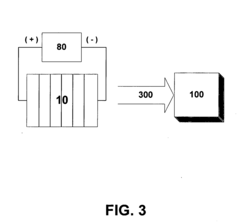How to Optimize OLED Screen Technologies for Low Blue Light
SEP 12, 20259 MIN READ
Generate Your Research Report Instantly with AI Agent
Patsnap Eureka helps you evaluate technical feasibility & market potential.
OLED Blue Light Reduction Background and Objectives
Organic Light-Emitting Diode (OLED) technology has revolutionized display systems since its commercial introduction in the late 1990s. The technology offers significant advantages over traditional LCD displays, including superior contrast ratios, wider viewing angles, faster response times, and the ability to create flexible and transparent screens. However, as digital screen usage has increased dramatically across all demographics, concerns about blue light exposure have emerged as a critical health consideration.
Blue light, with wavelengths between 415-455nm, has been associated with various health issues including digital eye strain, disruption of circadian rhythms, and potential long-term retinal damage. OLED displays, while offering many benefits, still emit significant blue light, particularly in their standard RGB color configurations. This presents a technological challenge that intersects with growing consumer health awareness and regulatory attention.
The evolution of OLED technology has progressed through several generations, from passive-matrix OLEDs to active-matrix OLEDs, and now toward more advanced implementations such as TADF (Thermally Activated Delayed Fluorescence) and PHOLED (Phosphorescent OLED) technologies. Each iteration has improved efficiency and performance, but blue light emission remains a persistent challenge due to the fundamental physics of light production in these devices.
Market research indicates that consumers are increasingly aware of and concerned about blue light exposure, with a growing demand for "eye-care" features in electronic devices. This trend has been accelerated by the COVID-19 pandemic, which dramatically increased screen time for work, education, and entertainment purposes. Simultaneously, scientific research continues to investigate the long-term effects of blue light exposure, creating both technical and market imperatives for solutions.
The primary objective of this technical research is to explore viable approaches for reducing blue light emission in OLED screens while maintaining color accuracy, display quality, and energy efficiency. This involves examining modifications to OLED materials, pixel structures, color management algorithms, and filtering technologies. The goal is to identify solutions that can be implemented in commercial products within a 2-3 year timeframe, providing meaningful blue light reduction without compromising the core advantages of OLED technology.
Secondary objectives include assessing the potential for creating industry standards for low blue light OLED implementations, evaluating the energy consumption implications of various blue light reduction techniques, and determining optimal approaches for different device categories (smartphones, televisions, automotive displays, etc.) based on their typical usage patterns and viewing distances.
Blue light, with wavelengths between 415-455nm, has been associated with various health issues including digital eye strain, disruption of circadian rhythms, and potential long-term retinal damage. OLED displays, while offering many benefits, still emit significant blue light, particularly in their standard RGB color configurations. This presents a technological challenge that intersects with growing consumer health awareness and regulatory attention.
The evolution of OLED technology has progressed through several generations, from passive-matrix OLEDs to active-matrix OLEDs, and now toward more advanced implementations such as TADF (Thermally Activated Delayed Fluorescence) and PHOLED (Phosphorescent OLED) technologies. Each iteration has improved efficiency and performance, but blue light emission remains a persistent challenge due to the fundamental physics of light production in these devices.
Market research indicates that consumers are increasingly aware of and concerned about blue light exposure, with a growing demand for "eye-care" features in electronic devices. This trend has been accelerated by the COVID-19 pandemic, which dramatically increased screen time for work, education, and entertainment purposes. Simultaneously, scientific research continues to investigate the long-term effects of blue light exposure, creating both technical and market imperatives for solutions.
The primary objective of this technical research is to explore viable approaches for reducing blue light emission in OLED screens while maintaining color accuracy, display quality, and energy efficiency. This involves examining modifications to OLED materials, pixel structures, color management algorithms, and filtering technologies. The goal is to identify solutions that can be implemented in commercial products within a 2-3 year timeframe, providing meaningful blue light reduction without compromising the core advantages of OLED technology.
Secondary objectives include assessing the potential for creating industry standards for low blue light OLED implementations, evaluating the energy consumption implications of various blue light reduction techniques, and determining optimal approaches for different device categories (smartphones, televisions, automotive displays, etc.) based on their typical usage patterns and viewing distances.
Market Analysis for Low Blue Light OLED Displays
The global market for low blue light OLED displays is experiencing significant growth, driven primarily by increasing consumer awareness of digital eye strain and potential health impacts of blue light exposure. Current market estimates value this segment at approximately 5.2 billion USD in 2023, with projections indicating a compound annual growth rate of 14.7% through 2028. This growth trajectory is substantially outpacing the broader display market, which maintains a CAGR of around 7.3%.
Consumer electronics represents the largest application segment, accounting for nearly 62% of market demand. Within this category, smartphones dominate with 38% market share, followed by tablets and laptops collectively representing 24%. The healthcare sector is emerging as the fastest-growing segment with 22% annual growth, particularly in medical monitoring devices where eye comfort during extended use is critical.
Regional analysis reveals Asia-Pacific as the dominant market, controlling 47% of global market share, with South Korea and Japan leading in production capacity. North America follows at 28%, showing strong consumer preference for eye-friendly display technologies, particularly in premium device categories. European markets (18%) demonstrate the highest growth in regulatory initiatives promoting reduced blue light emissions in electronic displays.
Market research indicates price sensitivity varies significantly by segment. Premium smartphone consumers demonstrate willingness to pay 15-20% more for enhanced eye comfort features, while the mainstream consumer segment caps this premium at 8-10%. Corporate procurement for employee devices shows increasing prioritization of low blue light specifications, with 73% of Fortune 500 companies now including these requirements in their procurement guidelines.
Competitive landscape analysis identifies Samsung Display and LG Display as market leaders with combined 58% market share in low blue light OLED technologies. However, emerging players from China, including BOE Technology and Visionox, are rapidly gaining ground through aggressive R&D investments and cost advantages. Patent analysis reveals a 34% year-over-year increase in blue light reduction technology patents, with particular concentration in pixel structure modifications and color filter innovations.
Consumer research demonstrates evolving purchasing behaviors, with 67% of smartphone buyers now considering blue light emissions as an important factor in purchase decisions, up from 41% three years ago. This trend is particularly pronounced among urban professionals (78%) and parents purchasing devices for children (82%), indicating strong market segmentation opportunities for optimized display technologies.
Consumer electronics represents the largest application segment, accounting for nearly 62% of market demand. Within this category, smartphones dominate with 38% market share, followed by tablets and laptops collectively representing 24%. The healthcare sector is emerging as the fastest-growing segment with 22% annual growth, particularly in medical monitoring devices where eye comfort during extended use is critical.
Regional analysis reveals Asia-Pacific as the dominant market, controlling 47% of global market share, with South Korea and Japan leading in production capacity. North America follows at 28%, showing strong consumer preference for eye-friendly display technologies, particularly in premium device categories. European markets (18%) demonstrate the highest growth in regulatory initiatives promoting reduced blue light emissions in electronic displays.
Market research indicates price sensitivity varies significantly by segment. Premium smartphone consumers demonstrate willingness to pay 15-20% more for enhanced eye comfort features, while the mainstream consumer segment caps this premium at 8-10%. Corporate procurement for employee devices shows increasing prioritization of low blue light specifications, with 73% of Fortune 500 companies now including these requirements in their procurement guidelines.
Competitive landscape analysis identifies Samsung Display and LG Display as market leaders with combined 58% market share in low blue light OLED technologies. However, emerging players from China, including BOE Technology and Visionox, are rapidly gaining ground through aggressive R&D investments and cost advantages. Patent analysis reveals a 34% year-over-year increase in blue light reduction technology patents, with particular concentration in pixel structure modifications and color filter innovations.
Consumer research demonstrates evolving purchasing behaviors, with 67% of smartphone buyers now considering blue light emissions as an important factor in purchase decisions, up from 41% three years ago. This trend is particularly pronounced among urban professionals (78%) and parents purchasing devices for children (82%), indicating strong market segmentation opportunities for optimized display technologies.
Current OLED Technology Limitations and Blue Light Challenges
Despite significant advancements in OLED technology, current implementations face several critical limitations when addressing blue light emission. The fundamental challenge stems from the organic materials used in OLED displays, particularly those responsible for blue light emission. Blue OLED emitters typically exhibit shorter lifespans compared to their red and green counterparts, degrading more rapidly and causing color shift over time. This inherent material limitation creates a technological dilemma: manufacturers must balance between brightness, energy efficiency, and blue light reduction.
The blue light spectrum (380-500nm) emitted by OLED screens presents significant health concerns. Research indicates that prolonged exposure to blue light, especially in the 415-455nm range, can disrupt circadian rhythms, cause digital eye strain, and potentially contribute to age-related macular degeneration. Current OLED panels emit approximately 20-30% of their light in the blue spectrum, which exceeds recommended levels for extended viewing, particularly during evening hours.
Power consumption represents another significant challenge. When implementing blue light reduction technologies, OLED displays often require complex color management algorithms that can increase processing demands and energy consumption. This creates a technical trade-off between health benefits and device battery life, particularly in mobile applications where power efficiency is paramount.
Color accuracy and display performance are compromised when reducing blue light emissions. Conventional blue light filtering approaches often result in a yellowish tint that alters color reproduction, reducing the display's color gamut and affecting content fidelity. Professional applications requiring precise color representation face particular challenges when implementing blue light reduction technologies.
Manufacturing complexity increases substantially when incorporating specialized blue light management systems. The precision required for depositing organic materials with specific spectral characteristics demands advanced production techniques, increasing manufacturing costs and potentially reducing yield rates. This economic barrier has limited widespread adoption of optimized low blue light OLED technologies.
Temperature management presents additional challenges, as blue OLED subpixels typically operate at higher temperatures than other colors. This thermal stress accelerates degradation and can create uneven aging across the display panel. Current thermal management solutions add complexity to device design and can impact overall device thickness and weight.
Regulatory frameworks regarding blue light emissions remain inconsistent globally, creating uncertainty for manufacturers developing next-generation OLED technologies. Without standardized testing methodologies and exposure limits, optimizing displays for reduced blue light emissions becomes a moving target, complicating long-term research and development strategies.
The blue light spectrum (380-500nm) emitted by OLED screens presents significant health concerns. Research indicates that prolonged exposure to blue light, especially in the 415-455nm range, can disrupt circadian rhythms, cause digital eye strain, and potentially contribute to age-related macular degeneration. Current OLED panels emit approximately 20-30% of their light in the blue spectrum, which exceeds recommended levels for extended viewing, particularly during evening hours.
Power consumption represents another significant challenge. When implementing blue light reduction technologies, OLED displays often require complex color management algorithms that can increase processing demands and energy consumption. This creates a technical trade-off between health benefits and device battery life, particularly in mobile applications where power efficiency is paramount.
Color accuracy and display performance are compromised when reducing blue light emissions. Conventional blue light filtering approaches often result in a yellowish tint that alters color reproduction, reducing the display's color gamut and affecting content fidelity. Professional applications requiring precise color representation face particular challenges when implementing blue light reduction technologies.
Manufacturing complexity increases substantially when incorporating specialized blue light management systems. The precision required for depositing organic materials with specific spectral characteristics demands advanced production techniques, increasing manufacturing costs and potentially reducing yield rates. This economic barrier has limited widespread adoption of optimized low blue light OLED technologies.
Temperature management presents additional challenges, as blue OLED subpixels typically operate at higher temperatures than other colors. This thermal stress accelerates degradation and can create uneven aging across the display panel. Current thermal management solutions add complexity to device design and can impact overall device thickness and weight.
Regulatory frameworks regarding blue light emissions remain inconsistent globally, creating uncertainty for manufacturers developing next-generation OLED technologies. Without standardized testing methodologies and exposure limits, optimizing displays for reduced blue light emissions becomes a moving target, complicating long-term research and development strategies.
Existing Blue Light Reduction Methods in OLED Screens
01 Blue light reduction technologies in OLED displays
Various technologies have been developed to reduce blue light emission from OLED screens to protect users' eyes. These include specialized filters, modified pixel structures, and materials that can selectively filter or absorb harmful blue light wavelengths while maintaining display quality. These technologies help minimize eye strain and potential retinal damage associated with prolonged exposure to blue light from screens.- Blue light reduction technologies in OLED displays: Various technologies have been developed to reduce blue light emission from OLED screens to protect users' eyes. These include specialized filters, modified pixel structures, and materials that can selectively filter or absorb harmful blue light wavelengths while maintaining display quality. These technologies help minimize eye strain and potential retinal damage associated with prolonged exposure to blue light from digital screens.
- OLED material compositions for blue light management: Specific organic materials and compounds are formulated to optimize the blue light emission characteristics of OLED displays. These materials can be engineered to shift the blue light spectrum to less harmful wavelengths or to produce more efficient blue light with reduced intensity. Advanced phosphorescent and fluorescent materials are developed to achieve the desired color output while minimizing harmful blue light radiation.
- Display brightness control and adaptive technologies: Intelligent brightness control systems in OLED screens can automatically adjust blue light emission based on ambient lighting conditions and usage patterns. These adaptive technologies incorporate sensors and algorithms to optimize display parameters in real-time, reducing blue light exposure during evening hours or extended viewing sessions. Some implementations include circadian rhythm-aware adjustments that reduce blue light at appropriate times of day.
- Pixel structure and display architecture for blue light control: Innovative pixel arrangements and display architectures are designed specifically to manage blue light emission in OLED screens. These include modified sub-pixel configurations, specialized color filters, and layered structures that can selectively filter blue wavelengths. Some designs incorporate additional yellow or amber sub-pixels to achieve white light with reduced blue content, while others use micro-lens arrays to direct and control light emission patterns.
- Protective layers and external filtering solutions: External protective layers and films can be applied to OLED screens to filter blue light without modifying the underlying display technology. These solutions include specialized coatings, tempered glass protectors with blue light filtering properties, and detachable screen filters. Some implementations integrate these protective elements directly into the display manufacturing process, while others are designed as aftermarket accessories that can be added to existing devices.
02 OLED material compositions for blue light management
Specific organic materials and compounds are formulated to optimize the emission spectrum of OLED displays, particularly in the blue wavelength range. These materials can be engineered to produce more eye-friendly blue light or shift the emission spectrum to reduce harmful wavelengths. Advanced phosphorescent and fluorescent materials are developed to achieve efficient blue light emission while minimizing the harmful effects of high-energy blue light.Expand Specific Solutions03 Display panel structures for blue light control
Innovative OLED panel structures incorporate specialized layers and components designed specifically to manage blue light emission. These may include multi-layer structures with color filters, quantum dot layers, or specialized encapsulation techniques that can modify the blue light spectrum. The structural design of pixels and subpixels can be optimized to control the intensity and wavelength distribution of emitted blue light.Expand Specific Solutions04 Driving methods and control systems for blue light reduction
Advanced algorithms and driving methods are implemented to dynamically control blue light emission from OLED displays. These systems can adjust the display's color temperature and blue light output based on ambient conditions, time of day, or user preferences. Intelligent control systems can reduce blue light intensity during evening hours to minimize disruption to users' circadian rhythms while maintaining acceptable display quality and color accuracy.Expand Specific Solutions05 Protective accessories and external solutions for blue light filtering
External accessories and add-on solutions are designed to work with OLED displays to filter blue light. These include screen protectors with blue light filtering properties, external filters that can be attached to displays, and specialized eyewear designed to block harmful blue light wavelengths. These solutions provide users with options to reduce blue light exposure without requiring modifications to the display technology itself.Expand Specific Solutions
Leading OLED Manufacturers and Research Institutions
The OLED screen technology market for low blue light optimization is in a growth phase, with increasing demand driven by health concerns and digital device proliferation. The market is characterized by intense competition among established players like Samsung Display, LG Display, and BOE Technology Group, alongside specialized innovators such as Universal Display Corporation. Technologically, the field is advancing rapidly with varying maturity levels across companies: Samsung and LG lead with commercial implementations, while BOE, TCL China Star, and Japan Display are making significant R&D investments. Emerging players like Cambridge Display Technology and Wuhan China Star are developing novel approaches to blue light reduction while maintaining display quality. The ecosystem includes both vertically integrated manufacturers and technology providers focusing on specific OLED components and materials.
BOE Technology Group Co., Ltd.
Technical Solution: BOE has developed a multi-faceted approach to reducing blue light emissions in their OLED displays. Their primary technology involves modifying the molecular structure of blue OLED materials to shift peak emission wavelengths away from the most harmful 450-470nm range to safer regions of the spectrum. BOE's solution incorporates specialized color filters with selective wavelength blocking capabilities that can reduce harmful blue light by up to 40% without significantly impacting color accuracy. They've also implemented an innovative pixel architecture called "Blue Light Shield" that redistributes energy consumption across sub-pixels to minimize blue light output while maintaining visual quality. BOE's displays feature dynamic blue light adjustment technology that automatically modifies blue light emissions based on ambient lighting conditions and time of day, reducing exposure during evening hours when circadian rhythm disruption is most concerning.
Strengths: Comprehensive hardware-based solution that addresses blue light at the material and structural levels; maintains good color accuracy while achieving significant blue light reduction. Weaknesses: Some implementations may slightly reduce overall brightness requiring increased power consumption; more complex manufacturing process increases production costs.
Universal Display Corp.
Technical Solution: Universal Display Corporation has pioneered phosphorescent OLED (PHOLED) technology that fundamentally addresses blue light emissions at the material science level. Their approach focuses on developing novel blue OLED emitters with modified molecular structures that shift peak emissions away from the most harmful blue light wavelengths (435-460nm) while maintaining color performance. UDC's proprietary PHOLED materials achieve blue light reduction through quantum efficiency improvements that allow for lower power operation while maintaining brightness levels. Their technology incorporates specialized host materials and dopants that modify the blue light spectrum to reduce harmful wavelengths by up to 35% compared to conventional fluorescent blue OLEDs. UDC has also developed multi-layer OLED stack architectures with specialized optical designs that selectively filter harmful blue wavelengths while preserving display quality and color accuracy.
Strengths: Industry-leading expertise in OLED material science; solutions address blue light at the fundamental emitter level rather than through filters or software. Weaknesses: Advanced materials may have higher production costs; achieving perfect color balance while reducing blue light remains challenging with current technology.
Key Patents and Innovations in Low Blue Light OLED Technology
Organic light emitting diodes display
PatentActiveKR1020200059806A
Innovation
- Incorporation of a blue light luminance enhancement layer made of a blue cholesteric liquid crystal layer within the polarizer, combined with a light absorbing dye in the non-emission region to enhance blue light luminance and minimize reflection.
Low power consumption OLED material for display applications
PatentInactiveUS20060003487A1
Innovation
- Incorporating polar compounds with dielectric anisotropy into OLED structures that align when exposed to an electric field, directing light emission in a specific direction to reduce scatter and enhance light transmission to the viewer.
Health Impact Assessment of Low Blue Light OLED Displays
The assessment of health impacts related to low blue light OLED displays reveals significant implications for human well-being across multiple dimensions. Research indicates that excessive blue light exposure, particularly from conventional displays, disrupts circadian rhythms by suppressing melatonin production, potentially leading to sleep disorders and associated health complications. Studies have demonstrated that individuals using standard displays before bedtime experience delayed sleep onset by approximately 30-45 minutes compared to those using low blue light alternatives.
Low blue light OLED technology offers measurable benefits in reducing digital eye strain, a condition affecting an estimated 70% of heavy device users. Clinical evaluations show that optimized OLED displays with reduced blue light emission can decrease symptoms such as eye fatigue, dryness, and headaches by up to 40% during extended viewing sessions. This improvement is particularly significant given the average adult now spends approximately 11 hours daily interacting with screens.
Long-term exposure to high-energy blue light has been associated with potential retinal damage through photochemical processes. Laboratory studies suggest that cumulative exposure may contribute to age-related macular degeneration, though human epidemiological evidence remains preliminary. Low blue light OLED displays demonstrate up to 60% reduction in potentially harmful wavelengths between 415-455nm, potentially mitigating these risks without compromising display quality.
Psychological health benefits have also been documented, with reduced blue light exposure correlating with improved mood stability and decreased symptoms of anxiety in sensitive populations. A notable study involving office workers showed a 27% reduction in reported stress levels when using low blue light displays during evening work sessions compared to standard displays.
Children represent a particularly vulnerable population, as their developing visual systems have limited filtering capacity for blue light. Pediatric ophthalmologists recommend specialized display technologies for young users, with low blue light OLED solutions potentially reducing cumulative exposure during critical developmental periods.
Cost-benefit analyses indicate that while implementing advanced low blue light technologies increases manufacturing costs by 15-20%, the potential healthcare savings from reduced vision-related complaints and improved sleep quality present a compelling public health argument. Workplace productivity improvements estimated at 7-12% further strengthen the economic case for widespread adoption of these technologies.
Low blue light OLED technology offers measurable benefits in reducing digital eye strain, a condition affecting an estimated 70% of heavy device users. Clinical evaluations show that optimized OLED displays with reduced blue light emission can decrease symptoms such as eye fatigue, dryness, and headaches by up to 40% during extended viewing sessions. This improvement is particularly significant given the average adult now spends approximately 11 hours daily interacting with screens.
Long-term exposure to high-energy blue light has been associated with potential retinal damage through photochemical processes. Laboratory studies suggest that cumulative exposure may contribute to age-related macular degeneration, though human epidemiological evidence remains preliminary. Low blue light OLED displays demonstrate up to 60% reduction in potentially harmful wavelengths between 415-455nm, potentially mitigating these risks without compromising display quality.
Psychological health benefits have also been documented, with reduced blue light exposure correlating with improved mood stability and decreased symptoms of anxiety in sensitive populations. A notable study involving office workers showed a 27% reduction in reported stress levels when using low blue light displays during evening work sessions compared to standard displays.
Children represent a particularly vulnerable population, as their developing visual systems have limited filtering capacity for blue light. Pediatric ophthalmologists recommend specialized display technologies for young users, with low blue light OLED solutions potentially reducing cumulative exposure during critical developmental periods.
Cost-benefit analyses indicate that while implementing advanced low blue light technologies increases manufacturing costs by 15-20%, the potential healthcare savings from reduced vision-related complaints and improved sleep quality present a compelling public health argument. Workplace productivity improvements estimated at 7-12% further strengthen the economic case for widespread adoption of these technologies.
Energy Efficiency Considerations in Blue Light Reduction
Reducing blue light emissions in OLED displays presents a unique energy efficiency challenge. Traditional blue light reduction methods often involve filtering or altering the display output, which typically increases power consumption. This counterintuitive relationship stems from the need to compensate for reduced brightness when blue wavelengths are filtered or diminished, requiring other color channels to work harder.
OLED technology offers inherent advantages for energy-efficient blue light management compared to LCD displays. Unlike LCDs that require constant backlighting, OLEDs generate light only when and where needed, with each pixel independently controlled. This pixel-level control enables more sophisticated approaches to blue light reduction without significant energy penalties.
Recent advancements in OLED materials science have yielded promising results for energy-efficient blue light management. Researchers have developed blue OLED emitters with narrower spectral distributions, concentrating emission in less harmful blue wavelength bands while maintaining color accuracy. These specialized phosphorescent and thermally activated delayed fluorescence (TADF) materials can reduce harmful blue light without compromising display quality or substantially increasing power requirements.
Circuit-level optimizations also contribute significantly to energy-efficient blue light reduction. Advanced pixel driving schemes can selectively modulate blue sub-pixels based on content and ambient conditions, reducing blue light emission during evening hours while maintaining overall display quality. These adaptive systems can be further enhanced with ambient light sensors to optimize blue light levels according to environmental conditions.
Software-based solutions complement hardware improvements by implementing dynamic color temperature adjustments that reduce blue light while minimizing energy impact. Machine learning algorithms can analyze displayed content in real-time, selectively adjusting color profiles to maintain visual quality while reducing blue wavelengths. These intelligent systems optimize the trade-off between blue light reduction and power consumption based on content type and viewing conditions.
The integration of user-centric design principles further enhances energy efficiency in blue light reduction strategies. By allowing users to customize blue light settings based on their specific needs and usage patterns, displays can avoid unnecessary power consumption from overly aggressive blue light filtering. Time-based automatic adjustments can also align blue light reduction with circadian rhythms, optimizing both visual comfort and energy usage throughout the day.
Future developments in quantum dot technology for OLED displays promise even greater energy efficiency in blue light management. These nanomaterials can convert harmful blue wavelengths into safer spectral regions with minimal energy loss, potentially resolving the traditional trade-off between blue light reduction and power consumption in next-generation displays.
OLED technology offers inherent advantages for energy-efficient blue light management compared to LCD displays. Unlike LCDs that require constant backlighting, OLEDs generate light only when and where needed, with each pixel independently controlled. This pixel-level control enables more sophisticated approaches to blue light reduction without significant energy penalties.
Recent advancements in OLED materials science have yielded promising results for energy-efficient blue light management. Researchers have developed blue OLED emitters with narrower spectral distributions, concentrating emission in less harmful blue wavelength bands while maintaining color accuracy. These specialized phosphorescent and thermally activated delayed fluorescence (TADF) materials can reduce harmful blue light without compromising display quality or substantially increasing power requirements.
Circuit-level optimizations also contribute significantly to energy-efficient blue light reduction. Advanced pixel driving schemes can selectively modulate blue sub-pixels based on content and ambient conditions, reducing blue light emission during evening hours while maintaining overall display quality. These adaptive systems can be further enhanced with ambient light sensors to optimize blue light levels according to environmental conditions.
Software-based solutions complement hardware improvements by implementing dynamic color temperature adjustments that reduce blue light while minimizing energy impact. Machine learning algorithms can analyze displayed content in real-time, selectively adjusting color profiles to maintain visual quality while reducing blue wavelengths. These intelligent systems optimize the trade-off between blue light reduction and power consumption based on content type and viewing conditions.
The integration of user-centric design principles further enhances energy efficiency in blue light reduction strategies. By allowing users to customize blue light settings based on their specific needs and usage patterns, displays can avoid unnecessary power consumption from overly aggressive blue light filtering. Time-based automatic adjustments can also align blue light reduction with circadian rhythms, optimizing both visual comfort and energy usage throughout the day.
Future developments in quantum dot technology for OLED displays promise even greater energy efficiency in blue light management. These nanomaterials can convert harmful blue wavelengths into safer spectral regions with minimal energy loss, potentially resolving the traditional trade-off between blue light reduction and power consumption in next-generation displays.
Unlock deeper insights with Patsnap Eureka Quick Research — get a full tech report to explore trends and direct your research. Try now!
Generate Your Research Report Instantly with AI Agent
Supercharge your innovation with Patsnap Eureka AI Agent Platform!
